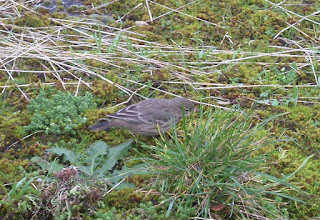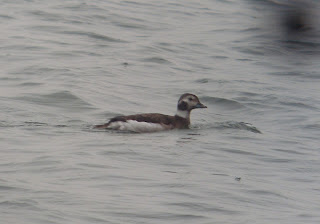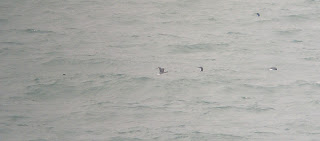My last day in Cornwall and it certainly ended on a big high! Stuart Croft kindly invited me on his regular monitoring rounds in search of Cirl Buntings and we were rewarded generously. Even the ferry crossing over onto the Roseland, was eventful with no fewer than
4 Great Northern Divers in the Carrick Roads.
I arrived at St Mawes at around 9ish and we were soon on our way scanning the fields and hedgerows in search of our target bird. We visited five sites in total, four of which had large feeding station providing millet seed for the birds, as well as a single
Brown Rat which we also encountered. Our first site (without a feeding station) proved to be very quiet and there were no signs of Cirl Buntings, only a few
Song Thrushes and
Meadow Pipits. On our second site, Stuart soon pinpointed a singing male, just out of sight unfortunately, but soon after located my first female
CIRL BUNTING flitting amongst some bracken at the edge of a dense hedge! Not long after we counted a total of at least
3 Cirl Buntings, including 2 males one of which was even in the mood for singing! On to the third site and we were rewarded with further views of another
4 Cirl Buntings (3 males, 1 female) feeding at very close quarters and along with a few,
Bullfinches,
Dunnocks and
Robins, two of which broke out into a full scale fight. We enjoyed their company for some time before moving on to our penultimate site, were we connected with a further
2 Cirls, (1 male and 1 female) followed by a brief visit to the final site to find yet another
2 Cirl Buntings, again a male and female. In total that makes
11 CIRL BUNTINGS, impressive!
St Mawes crossing from Falmouth
my first ever female Cirl Bunting!
one of the stunning males
taking a break from singing
feeding very close to where we were stood at one of the feeding stations
To end the day with a bit of variety, we bypassed one of the many creeks before moving on to Portscatho. Here, we counted a total of at least
8 Mediterranean Gulls,
6 Red-breasted Merganser, including two courting males and a small selection of waders such as
Curlew,
Redshank,
Greenshank, and a
Little Egret.
It had only just gone midday and the majority of the trip was already complete but not without a brief stop at Portscatho to pay our respects to the
female LONG-TAILED DUCK which was easily picked up before even stepping out of the car! Equally exiting were
3-4 SLAVONIAN GREBES also in the immediate area, diving regularly but still within good range for us to appreciate their smart winter plumage. Also in the bay were
c.18 Common Scoter,
1 Guillemot,
1 Great Northern Diver and several more
Mediterranean Gulls.
Slavonian Grebe, perhaps not the best pic I could have got but rather showy non the less
female Long-tailed Duck
With an excellent mornings birding behind us, I headed back over with the ferry to Falmouth. One last
Great Northern Diver, and it was time to pack my bags in preparation for my journey back to Herts. Till next year Cornwall, thanks for all the great birds so far.
Many many thanks Stuart Croft for allowing me to join you on your monitoring trip, it was a very enjoyable days birding and I look very much forward to seeing the future success of the Cirl Bunting project I wish you all the best with it!

















































